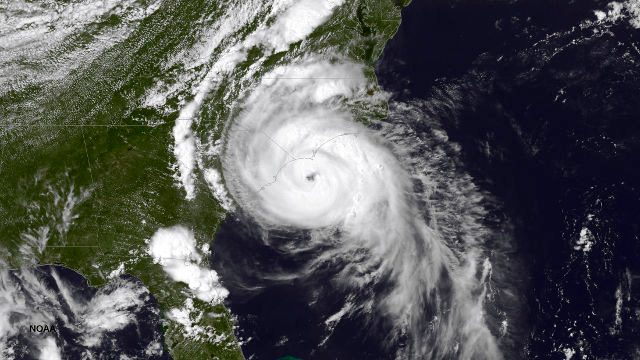SUMMARY
This is AI generated summarization, which may have errors. For context, always refer to the full article.

MIAMI, USA – Hurricane Arthur, downgraded to a category one storm, carried its still-fierce winds and drenching rains toward the US northeast Friday, July 4, after getting the July 4 holiday off to a soggy start for vacationers further south.
By morning, Arthur, which had crashed ashore in North Carolina overnight as a category two storm, had lost a bit of its punch, with maximum sustained winds of 90 miles (150 kilometers) per hour holding steady throughout the day.
Officials from the National Hurricane Center in Miami said the storm was likely to weaken further as it chugged northward on its mission to ruin Independence Day celebrations in the New England region of the US northeast.
North Carolina’s Governor Pat McCrory, visibly relieved at a morning press conference, reported that other than some flooding, beach erosion and power outages, his state was by and large spared the worst possible effects from Arthur.
North Carolina ‘open for business’
“North Carolina beaches are open for business,” McCrory said, beckoning visitors who might have scuttled travel plans during the holiday weekend – the most lucrative for his state’s flourishing tourist industry.
“We want to say come visit the North Carolina beaches,” he said, adding that “(beach) umbrellas are going up as we speak right now.”
The storm threatened to derail traditional Independence Day weekend picnics, parades and fireworks displays for millions of Americans along the East Coast, as far north as New England.
The NHC’s 1500 GMT advisory said Arthur was located about 100 miles (165 kilometers) southeast of Ocean City, Maryland, and was heading toward the northeast at 24 miles (39 kilometers) per hour.
By early Saturday the storm was supposed to arrive in Nova Scotia, Canada, after first passing east of New England.
The tempestuous weather system already caused city officials to make adjustments to July 4 festivities in Boston, where the traditional annual fireworks display was held one day early, Thursday night, July 3.
Other northeastern towns likely to be in Arthur’s path, like Westport, Connecticut, said they would push back their fireworks to Monday, July 7, by which time the storm will be long gone.
As dawn broke on a disrupted holiday for tens of thousands of vacationers, television footage showed fierce winds and horizontal rain in the resort region of the Outer Banks of North Carolina, the long and thin series of barrier islands where the storm made landfall late Thursday.
Trees bent wildly in the gusting rain as gushing streams of water flowed in streets.
The Atlantic hurricane season began June 1 and runs through November 30.
The NHC said the first hurricane of the season carried damaging waves and powerful tidal surges, and left behind up to a half-foot (15 centimeters) in rainfall.
Some evacuations had been ordered as the hurricane approached. It finally came ashore as a category two hurricane, on a scale in which five is the highest.
The hurricane will weaken over the next two days into a post-tropical depression Friday night or Saturday, the Miami-based hurricane center said.
Holdouts brave Arthur’s winds, rain
Thousands of people lost power in North Carolina, news reports said, and there was localized flooding in areas including the coastal city of Wilmington.
Emergency declarations were issued by several counties in the southern state, which opened emergency shelters and ordered evacuations in low-lying areas.
But, as always, there were holdouts.
“I don’t take these storms lightly, but I’ve never left during a hurricane,” Renee Cahoon, 58, the former mayor of Nags Head on the Outer Banks, told the Los Angeles Times.
She owns a grocery store and has lived in a beachfront home for more than 40 years. She planned to reopen her shop later Friday.
As many as half a million visitors had been expected in the coastal Carolinas for the national holiday, the region’s biggest tourist weekend.
Will Sessoms, mayor of Virginia Beach, Virginia, told MSNBC television Friday that the storm was calming down in his town as well.
“Our winds are dying down. They’re down to about 20 to 25 miles an hour sustained,” he said.
But he reiterated the warning from officials that waters roiled by a hurricane could remain deadly for hours after a storm departs.
“The key thing is to stay out of the water. The waves are big. We have a lot of rip currents and we don’t want anyone to lose their life out in that water,” he said. – Rappler.com
Add a comment
How does this make you feel?
There are no comments yet. Add your comment to start the conversation.